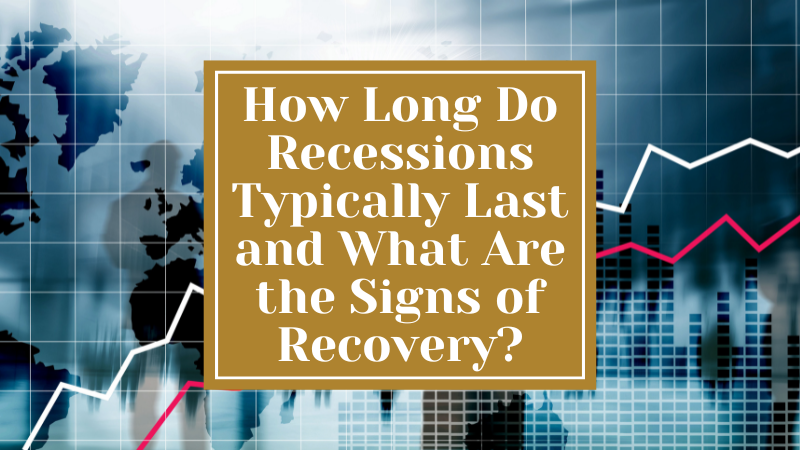In economic times, it seems that everyone is throwing out words like recession and estimating when the next one will happen, how bad will it be, and how long will it last. This creates fear and worry in many people.
So, today, let’s not talk about the impacts of a recession, but the recovery signs of a recession. They sound scary, but they are often more short-term than people realize and offer much room for growth and advancement when over.
In this article, we delve into the historical patterns of recession durations, shedding light on the average length of these economic downturns. Additionally, we unravel the indicators that signify a turning point, as economies gradually emerge from the depths of recession towards the path of growth and stability.
So, let’s dive in.
How Long Do Recessions Typically Last in the United States
The average length of a recession can vary significantly depending on various factors, including the underlying causes, the severity of the downturn, and the policy responses implemented. Historically, recessions have lasted anywhere from a few months to a couple of years.
Looking at data from the United States, which has experienced several recessions over the years, the average length of post-World War II recessions is around 11 months. However, it’s important to note that this is an average, and individual recessions can deviate from this duration. Some recessions have been relatively short-lived, lasting six to nine months, while others have been more prolonged, lasting for over a year or even two years.
It’s worth mentioning that the duration of recessions can also be influenced by government interventions, monetary policy actions, and overall global economic conditions. For example, during the global financial crisis in 2008-2009, the recession lasted longer than the historical average due to the severity of the crisis and the subsequent recovery challenges. The Great Recession lasted for about 18 months.
Recently, the United States also experienced one of the shortest recessions on record, just two months from March to April of 2020.
It’s important to keep in mind that economic cycles and recessions are natural parts of the business cycle, and their durations can be influenced by a wide range of factors. Therefore, while historical averages can provide some perspective, the length of a recession can vary significantly from one instance to another.
The signs of recovery in an economy after a recession can include:
Knowing the signs that a recession is a recovery can be a great comfort to many individuals. When they start to see signs that a recession is recovering, many people can breathe a little easier. Here are some signs to look for:
1. Positive GDP growth: One of the primary indicators of recovery is when the Gross Domestic Product (GDP) starts to show positive growth. This indicates that the overall output of goods and services in the economy is increasing.
2. Expansion of job opportunities and declining underemployment: A recovering economy often leads to the creation of new job opportunities, reducing unemployment rates. Additionally, underemployment (where individuals are employed but working part-time or in jobs below their skill level) may decline as more full-time and suitable employment options become available.
3. Increased consumer spending: During a recession, consumer spending tends to decline. A sign of recovery is when consumer confidence improves, and people start spending more on goods and services, indicating a strengthening economy.
4. Improved business profitability: Companies’ financial statements can provide insights into the state of recovery. Rising corporate earnings, profitability, and positive financial performance across various sectors indicate a strengthening economy. During a recovery, businesses often experience improved profitability as consumer demand picks up and operational efficiency increases. Rising profits indicate a healthier business environment and can lead to increased investment, expansion, and job creation.
5. Stock market performance: Stock markets often reflect investor sentiment and overall economic health. Recovery may be indicated by a sustained upward trend in stock market indices, indicating increased investor confidence and positive expectations for the future.
6. Monetary policy measures: Central banks may implement expansionary monetary policy, such as lowering interest rates or injecting liquidity into the economy, to stimulate lending and investment. These measures can support economic recovery.
7. Government stimulus and fiscal policies: Governments can implement fiscal policies like tax cuts, infrastructure spending, or financial assistance programs to stimulate economic activity and support recovery.
8. Increased business and consumer confidence: As the economy starts to recover, there is often a rise in business and consumer confidence. Business leaders become more optimistic about future prospects, leading to increased investments, expansion plans, and hiring. Consumer confidence improves as people feel more secure about their financial situations and are more willing to make major purchases. Surveys and indices measuring consumer sentiment can provide insights into the state of recovery.
9. Housing market recovery: A rebound in the real estate market, including increased home prices, higher sales volumes, and new construction projects, can indicate a recovering economy. The real estate sector plays a crucial role in overall economic health, and its resurgence can contribute to economic growth.
10. Improving credit conditions: During a recession, credit availability may be limited, and interest rates can be high. As the economy recovers, credit conditions typically improve, with banks and financial institutions becoming more willing to lend. Lower interest rates and increased credit availability can stimulate investment and consumer spending.
11. Rising industrial production and manufacturing activity: A recovery is often accompanied by an increase in industrial production and manufacturing activity. As consumer demand picks up, factories and industries experience higher production levels, leading to job creation and economic growth.
12. Stable or decreasing inflation: Inflation refers to the general increase in prices of goods and services. During a recession, inflation may be low or even negative. As the economy recovers, inflation tends to stabilize or increase moderately, indicating a healthier and more balanced economy.
13. Rebounding international trade: International trade plays a significant role in many economies. A sign of recovery is an increase in export and import volumes, as it indicates improved demand for goods and services in both domestic and international markets. This can be seen through rising trade volumes, increased trade agreements, and improved trade balances.
14. Declining government deficits: During a recession, governments often implement expansionary fiscal policies, leading to increased spending and potential budget deficits. As the economy recovers, government deficits may decrease as tax revenues improve and spending stabilizes. This indicates a healthier fiscal position and a more sustainable economic trajectory.
15. Increased business investment: A sign of recovery is when businesses regain confidence and start investing in capital expenditures, research and development, and other growth initiatives. Increased business investment suggests a positive outlook for future profitability and economic expansion.
16. Reduction in government intervention: During a recession, governments often intervene with various measures such as stimulus packages, bailouts, and regulatory interventions. As the economy recovers, the need for such extensive government intervention diminishes, and a more market-driven environment emerges.
17. Recovery in specific sectors: While an overall economic recovery is desirable, specific sectors may show signs of recovery earlier than others. For example, sectors like technology, healthcare, or renewable energy may rebound faster and display positive growth trends, indicating pockets of economic strength.
18. Strengthening of the currency: In some cases, a recovering economy may experience a strengthening of its currency relative to other currencies. This can indicate improved investor confidence, increased foreign investment, and a more stable economic outlook.
19. Resilience in financial institutions: During a recession, financial institutions may face challenges such as loan defaults or liquidity issues. As the economy recovers, these institutions demonstrate resilience, improved balance sheets, and a return to stable lending practices. It indicates a healthier financial sector and contributes to overall economic stability.
20. Positive economic forecasts and expert opinions: Economists, financial analysts, and research institutions closely monitor economic indicators and provide forecasts and opinions on the state of recovery. Positive economic forecasts and expert consensus can further reinforce confidence in the recovery process.
21. Growing business startups and entrepreneurship: Economic recovery can foster an environment conducive to entrepreneurship and new business ventures. As confidence increases, individuals may be more inclined to start their own businesses, contributing to job creation, innovation, and economic growth.
22. Reinvestment in research and development (R&D): Economic recovery can incentivize businesses to reinvest in R&D activities. Increased R&D expenditures indicate a focus on innovation, technology advancement, and long-term growth prospects.
23. Consumer and business travel trends: The recovery of the travel and tourism industry can serve as an indicator of economic improvement. Increasing travel activity, both for leisure and business purposes, suggests restored confidence, discretionary spending, and economic vitality.
It’s important to remember that these signs of recovery can vary depending on the specific economic conditions and the nature of the recession. Recovery is a gradual process, and different sectors and regions may experience varying degrees of improvement. These signs of recovery may not occur simultaneously or in a linear fashion. Economic recoveries can be gradual and may involve fluctuations and periods of uncertainty. Monitoring multiple economic indicators and expert analysis can provide a more comprehensive understanding of the recovery process.
You May Also Enjoy: What Are the Causes of a Recession and How Can They Be Identified?
Can Anything Be Done to Decrease the Length of a Recession?
To decrease the length of a recession, various measures can be taken to stimulate economic activity and restore confidence. Governments and central banks play a crucial role in implementing these strategies.
Central banks can employ expansionary monetary policies by lowering interest rates and increasing the money supply. This encourages borrowing, investment, and consumer spending, which can help revitalize the economy.
Additionally, governments can implement fiscal stimulus measures such as increased government spending, tax cuts, or direct cash transfers to individuals and businesses. These measures aim to boost aggregate demand, create jobs, and stimulate economic growth.
Ensuring the stability of the financial sector is also essential, and governments can provide support through measures like bank bailouts, liquidity injections, and regulatory reforms. Moreover, investing in infrastructure projects can create jobs, generate economic activity, and enhance long-term productivity.
Lastly, supporting small businesses, often hit hard during recessions, can help sustain employment and promote economic recovery. By implementing these strategies, policymakers can work to mitigate the negative impact of recessions and facilitate a quicker return to economic growth.
Final Thoughts on Recession Lenghts and Recovery Signs
As we conclude this captivating exploration of recessions and their signs of recovery, we are reminded of the dynamic nature of economic cycles. The length of recessions, as we have seen, can vary based on a multitude of factors, making each downturn a unique challenge.
However, the presence of distinct signs of recovery offers hope for brighter days ahead. From the gradual stabilization of key economic indicators to the resurgence of consumer and business confidence, these signs point towards a gradual return to growth and prosperity.
While navigating through the twists and turns of recessions can be daunting, understanding the patterns and indicators of recovery equips us with valuable insights. By keeping a watchful eye on these signs and learning from the past, we can better prepare for the opportunities and challenges that lie ahead.
So, let us remain vigilant, adaptable, and resilient as we traverse the ever-evolving landscape of economic cycles, knowing that the dawn of recovery will inevitably follow the darkest nights of recession.
How do you prepare to weather a recession? Share with us in the comments below!




